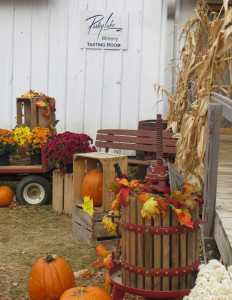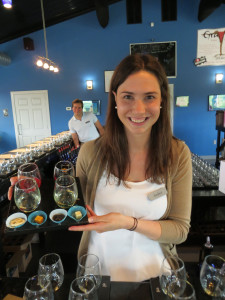Drinking Midwest Wine is Good For You
One objection to buying regional wine is that regional wine costs more. One would think that a local wine producer has a built in cost advantage in the form of lower shipping costs. But in reality, global wine producers use massive economies of scale and cheap shipping costs to keep imported wine costs low.

Parley Lake WInery in Waconia, MN, just outside the Twin Cities, combines quality wine with an authentic farm experience.
For example, shipping Malbec from Buenos Aires to Houston in a 20 foot container only costs about 13 cents a bottle. This Argentinian Malbec sells for $7-$8 a bottle at the local grocery store and it’s decent wine. (That’s if the metal shipping container holding the wine does not get fried on the dock in Houston.)
Another reason Midwest wine is relatively expensive is that Midwest wine is made from grapes grown and harvested by hand in relatively small vineyards.
Michigan is the largest wine producing state in the Midwest crushing something over 10,000 tons of wine grapes per year. While this is a lot of grapes, consider that Gallo reportedly crushes over 400,000 tons of grapes annually at what is essentially a wine factory in California. Gallo makes very drinkable Barefoot Wine, the number one wine brand in the U.S., which sells for $7.
So why would you want to pay more for a quality bottle of local wine when the world is awash is decent inexpensive wine?
First, because a lot of Midwest regional wine is now very good.
“Oh really?,” you say, “Prove it.”
That’s a fair request. At the end of this article are links to some of the national wine contests that Midwest wines have been winning recently. Repeatedly winning top awards at national and international wine contests like the Finger Lakes Wine Competition and the Pacific Rim Competition is not a fluke. The judges at these contests are all experts and they are usually tasting blind.
So why are Midwest wines now winning so many awards?
The primary reason Midwest wines win major awards is because they are flawlessly made. If your perception of Midwest wine is based on anything older than the past couple of years, then you need to taste Midwest wine again. (If you want to know what wineries to visit, see the “Winery Profile” section of Midwest Wine Press.)
Aside from quality, there are other reasons that it is in your enlightened self-interest to buy local wine. At some point in the forseeable future, it may become advantageous for individuals and manageable groups of individuals to have at least a partially self-sufficient food supply.
Promoting regional agriculture does not require’going off the grid.” An easier way to start transitioning to a new dynamic is to drink local wine and buy local food whenever possible.
No matter where you live, your well-being is attached to the well-being of your neighbor. Would you rather send your dollars far away or spend them locally where there’s a chance that they will benefit you in some fashion?
And local wine keeps not only keeps some of your money around where you live, it also promotes local fruit production. If the world does indeed become smaller, living in a region that can provide for its own food needs will be advantageous.
Wine grapes are known in agricultural circles as a “value added” crop. That’s because wine made from local grapes sells for a large multiple of the cost of the grapes. For example, a ton wine grapes produces about 720 bottles of wine. A ton of Midwestern wine grapes sells for about $1,500, but the wine made from these grapes will be worth about $9,000 when bottled and sold. This pricing arrangement allows both the grape grower and winery to make a modest profit, which results in local employment.
Drinking local wine is also good for the environment for several reasons. Shipping food and beverages is one of the largest uses of fossil fuels. Some of the cross continental shipping of heavy grapes and wine would be eliminated if we all drank more local wine.
Diversification of agriculutire also has benefits. Everyone knows corn and soy farming is a big, successful business in our region. Unfortunately, giant monoculture farms have downsides too. Pests and weeds in enormous single crop fields have an easier time getting established and can become harder to kill. Bugs and weeds never stop mutating, so we have to keep hitting them with more and stronger chemicals to keep row crop yields high.
The long-term losers in this war between large-scale agriculture and nature could be us. Glyphosate, the main ingredient in commercial weed killers, is already present in most waterways in the Midwest. Having a more diverse range of crops (like Michigan does) is healthier for the environment because different plants have different defenses to natutal predators.
Local wine and local food are also fun. Tastebuds that you didn’t know you had will spring back to life when you taste something fresh and different.
If you drink local wine, you will also meet people involved in the production of the wine and interact with them face to face.
But here’s the best part about regional wine in my opinion: Find a regional winery with a vineyard you can enter. (Please get permission first.) Walk between the rows of grapes a bit. Maybe taste a berry if they haven’t been sprayed recently. Then go in the tasting room and enjoy the wine. It may not happen the first time, but eventually your senses will pick up a connection between the grapes in the vineyard and the grapes in the wine.
And please remember to also pick up a bottle of local wine next time you’re in the store. The few extra bucks you spend helps to keep the world in balance.
2013 San Fransisco International Wine Competition Midwest Winners
2013 San Francisco Chronicle Gold Medal Winners from the Midwest
2013 Finger Lakes International Wine Competition Midwest Winners
Midwest Dominates Pacific Rim Wine Competition
Laurentide Winery Wins Riesling Challenge at International Eastern Wine Competition
Michigan Wines Shine at San Francisco Chronicle Wine Competition
2013 Indy International Wine Competition Top Finishers
Midwest Wines Win at the Los Angeles International Wine Show
Midwest Wineries Win Big at 2012 Finger Lakes Wine Competition




